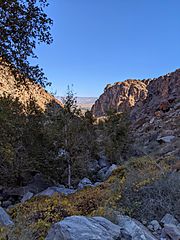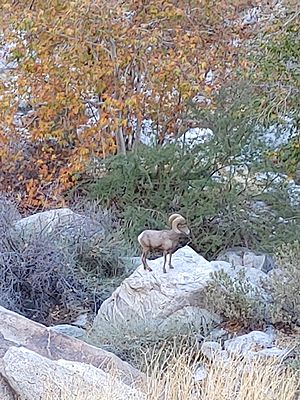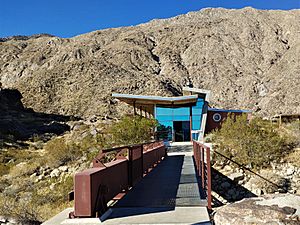Tahquitz Canyon facts for kids
Quick facts for kids Tahquitz Canyon |
|
|---|---|

Tahquitz Canyon view toward Palm Springs
|
|
| Floor elevation | 351 ft (107 m) |
| Geography | |
| Location | San Jacinto Mountains Palm Springs, California |
| Rivers | Tahquitz Creek |
| Elevation listed is for Tahquitz Creek | |
Tahquitz Canyon is a special place in Palm Springs, California. It's part of the Agua Caliente Indian Reservation. This canyon stretches down from the San Jacinto Mountains in Riverside County. For over 5,000 years, the Cahuilla people, a Native American tribe, lived here.
Tahquitz Canyon is very important to the Cahuilla culture. Today, it is a nature preserve. The Agua Caliente Band of Cahuilla Indians takes care of it, and visitors can explore its beauty. There is another place in Riverside County also called Tahquitz Canyon. It's a smaller canyon within Martinez Canyon in the Santa Rosa Mountains.
Contents
What is the Legend of Tahquitz?
Tahquitz Canyon is famous for a special legend. The Agua Caliente Cahuilla people have many stories about a powerful spirit named Tahquitz. Most stories say Tahquitz was a strong nukatam, which means a shaman or spiritual leader. He was created by Mukat, the world's creator in Cahuilla mythology.
One legend tells that Tahquitz fell in love with a young woman. He took her to Tahquitz Canyon, and they lived there for years. But she was unhappy and wanted to leave. Tahquitz let her go, but he warned her not to tell anyone what had happened. She didn't listen and told her people. Because of this, Tahquitz used his power, and she died.
The legend says Tahquitz is immortal, meaning he lives forever. He can still give power to worthy nukatam. But he also takes the souls of people who go too far into his canyon at night. People say he causes earthquakes in the area. Sometimes, he appears as a bright green light or a meteor in the sky. Other stories say Tahquitz was a normal man who gained his powers after leaving his people.
Who Lived in Tahquitz Canyon?
Long ago, the Colorado River sometimes flowed into the Salton Basin. This created a huge lake called Lake Cahuilla. This lake was a major food source for the native people. It had many fish and attracted lots of birds. Today, the Salton Sea is what's left of the lowest part of Lake Cahuilla.
Eventually, the Colorado River stopped filling Lake Cahuilla. The lake slowly dried up. This meant less fresh water, fish, and birds for the Cahuilla people. So, they had to move to new places with water. Tahquitz Canyon, along with Andreas Canyon, Palm Canyon, and Murray Canyon, became important homes.
The Cahuilla people living in the canyon created rock carvings. Most of these ancient artworks are now gone. Archaeologists have found stone tools in the canyon. These include tools made from soapstone that were used to straighten arrows. They also found pieces of broken ceramic pots called ollas. These pots were used to hold water, seeds, and sometimes the remains of their ancestors.
Before outsiders arrived, the Agua Caliente people built irrigation ditches in the canyon. These ditches helped carry water to their crops.
Exploring Tahquitz Canyon Today
The Agua Caliente Band of Cahuilla Indians manages a visitor's center and a hiking trail in the canyon. The trail is a two-mile loop. It leads hikers to the beautiful Tahquitz Falls and then back to the start.
What About Wildlife in the Canyon?

Tahquitz Canyon is home to various animals. In 2010, scientists helped bring back the endangered Mountain yellow-legged frog to Tahquitz Creek. This frog had been rediscovered in the area in 2009. Researchers from the San Diego Zoo, U.S. Fish and Wildlife Service, and California Department of Fish and Game worked together on this project.
Tahquitz Canyon in Movies and Plays
From 1921 to 1930, Tahquitz Canyon was a stage for outdoor plays. These "Desert Plays" included "Fire" and "The Arrow Maker" by Mary Hunter Austin. There was also a play based on the legend of Tahquitz, written by Garnet Holme.
The beautiful Tahquitz Falls also appeared in a famous movie. They were used as a scene in Frank Capra's 1937 film, Lost Horizon.


